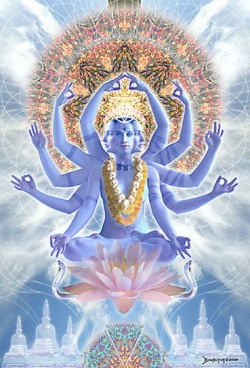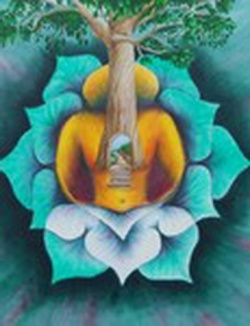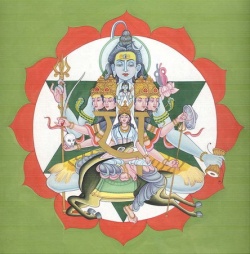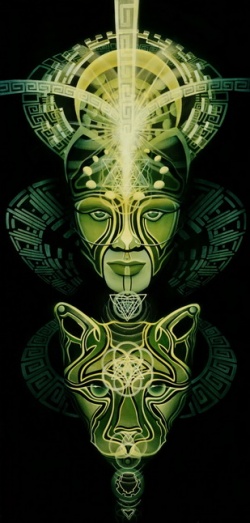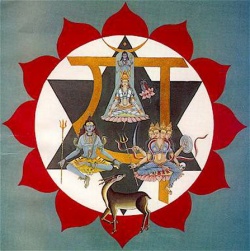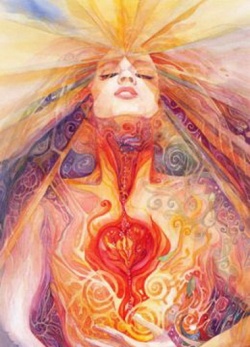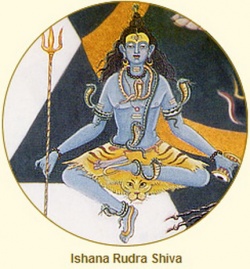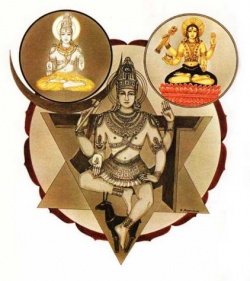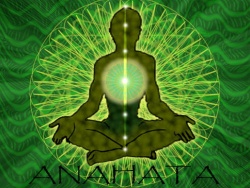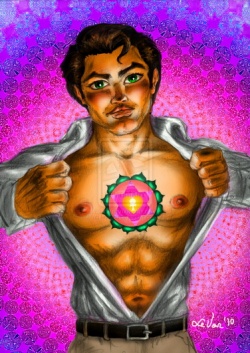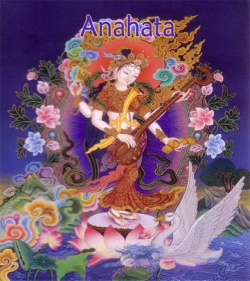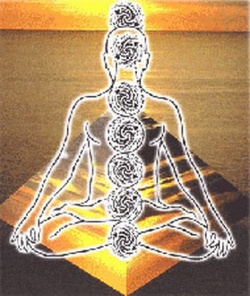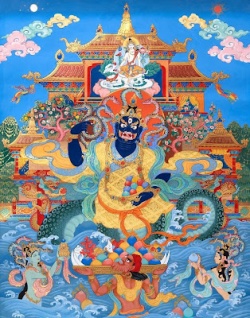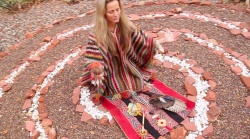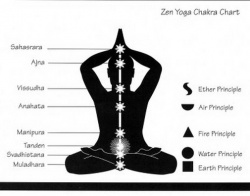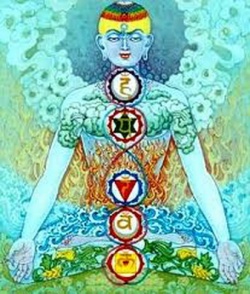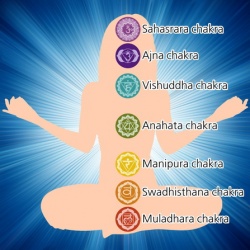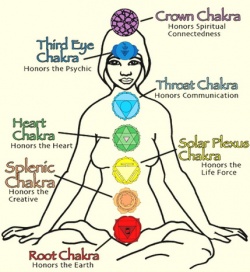Chakra
Chakra (Cakra, Skt); ’khor lo / rtsa ’khor (Tib).
This literally means wheel. In the Vajrayana context, it refers to the energy centres which occur at the junction of the three nadis.
There are seven Chakras generally recognised.
Within Vajrayana, five of these are regarded as especially significant.
These are the crown, throat, heart, navel and secret chakras.
chakra: Literally, “wheel” or “circle.”
It is a term for the centers of subtle or refined energy in the human body.
These centers of energy are considered to be sources for psychic or spiritual powers.
They can be manipulated by the dharma protectors to allow for the development of supernormal powers.
The Buddha taught a different system of developing the chakras than that followed by other Indian methods.
There are five chakras recognized in the Buddhist system of yoga.
chakra
輪宝・輪 (Skt; Jpn rimbo or rin )
Also, chakra treasure or wheel treasure.
One of the seven treasures that a wheel-turning king (Skt chakravarti-raja ) is said to possess.
A wheel-turning king was a wise and benevolent ruler, an ideal king in Indian mythology.
The Sanskrit word chakra means the wheel of a carriage.
The seven treasures of a wheel-turning king are a
chakra,
elephants,
horses,
jewels,
jewel-like women,
excellent ministers of financial affairs, and
generals.
A chakra, or wheel, is of four kinds:
gold,
silver,
copper, and
iron.
A wheel-turning king possesses one or another of these four kinds of wheels, an indication of his rank.
Turning his chakra, a wheel-turning king advances without hindrance, overthrows his enemies, establishes peace, and rules with justice and benevolence wherever he goes.
In Buddhism, a chakra is regarded as a symbol of the Buddha's teachings, which vanquish earthly desires and illusions.
The word dharma-chakra, or the wheel of the Law, is often used to describe the teachings.
The Buddha's preaching is expressed as "the turning of the wheel of the Law."
In the history of Buddhism, before images of the Buddha appeared, the Buddha was depicted in carvings symbolically as a wheel, a bodhi tree, and other images.
A chakra was originally a wheel- or disk-shaped weapon in ancient India that was hurled as a missile at enemies.
Chakras, in Hindu metaphysical tradition and other belief systems, are centers of Prāṇa, life force, or vital energy.
Chakras correspond to vital points in the physical body i.e. major plexuses of arteries, veins and nerves.
Texts and teachings present different numbers of chakras.
Their name derives from the Sanskrit word for "wheel" or "turning"
The concept of chakra features in tantric and yogic traditions of Hinduism and Buddhism.
Etymology
Bhattacharyya's review of Tantric history says that the word chakra is used to mean several different things in the Sanskrit sources:
"Circle," used in a variety of senses, symbolizing endless rotation of shakti.
A circle of people.
In rituals there are different cakra-sādhanā in which adherents assemble and perform rites.
According to the Niruttaratantra, chakras in the sense of assemblies are of 5 types.
The term chakra also is used to denote yantras or mystic diagrams, variously known as trikoṇa-cakra, aṣṭakoṇa-cakra, etc.
Different "nerve plexus within the body."
In Buddhist literature the Sanskrit term cakra (Pali cakka) is used in a different sense of "circle," referring to a Buddhist conception of the Cycle of Rebirth consisting of six states in which beings may be reborn.
The linguist Jorma Koivulehto wrote (2001) of the annual Finnish Kekri celebration having borrowed the word from early Indo-Aryan. Indo-European cognates include Greek kuklos, Lithuanian kaklas, Tocharian B kokale and English "wheel," as well as "circle."
Cognates of "chakra" still exist in modern Asian languages as well.
In Malay, "[[cakera]" means "disc," e.g. "cakerva padat" = "compact disc."
History
While breath channels (nāḍis) of yogic practices had already been discussed in the classical Upanishads, it was not until the eighth-century Buddhist Hevajra Tantra and Caryāgiti, that hierarchies of chakras were introduced.
==Characteristics==
the Texts and teachings present different numbers of chakras.
Also different physical structures are considered chakras.
David Gordon White thus emphasises:
"In fact, there is no "standard" system of the cakras.
Every school, sometimes every teacher within each school, has had their own chakra system."
The following features are common:
They form part of the body, along with the breath channels, or nadis, and the winds (vayus).
They are located along the central channel (sushumna/avadhūtī).
Two side channels cross the center channel at the location of the chakras.
They possess a number of 'petals' or 'spokes'.
They are generally associated with a mantra seed-syllable, and often with a variety of colors and deities.
==Use in religious traditions==
==Hindu Tantra==
David Gordon White traces the modern popularity of the "Hindu" seven chakra system to Arthur Avalon's The Serpent Power, which was Avalon's translation of a late work, the Satcakranirupana.
In actuality, there are several models and systems present in Hindu tantric literature, as White documents.
Kundalini is a feature of Hindu chakra systems.
==Buddhist Tantra==
===Vajrayana===
Chakras play an important role in the main surviving branch of Indian Vajrayana, Tibetan Buddhism.
They play a pivotal role in completion stage practices, where an attempt is made to bring the subtle winds of the body into the central channel, to realize the clear light of bliss and emptiness, and to attain Buddhahood.
The Vajrayana system states that the central channel (avadhūtī) begins at the point of the third eye like of lord Shiva, curves up to the crown of the head, and then goes straight down to the lower body.
There are two side channels,
the rasanā and
lalanā,
which start at their respective nostrils and then travel down to the lower body.
The apāna vāyu governs the lower terminations of the three channels.
The lower end of the central channel ends in the rectum.
The lower end of the lalanā ends in the urinary tract.
The lower end of the rasanā channel emits semen.
The side channels run parallel to the center channel, except at locations such as the navel, heart, throat and crown (i.e. chakras) where the two side channels twist around the central channel.
At the navel, throat and crown, there is a twofold knot caused by each side channel twisting once around the central channel.
At the heart wheel there is a sixfold knot, where each side channel twists around three times.
An important part of completion stage practice involves loosening and undoing these knots.
Within the chakras exist the 'subtle drops'.
The white drop exists in the crown, the red drop exists in the navel, and at the heart exists the indestructible red and white drop, which leaves the body at the time of death.
In addition, each chakra has a number of 'spokes' or 'petals', which branch off into thousands of subtle channels running to every part of the body, and each contains a Sanskrit syllable.
By focusing on a specific chakra (while often holding the breath) the subtle winds enter the central channel.
The chakra at which they enter is important in order to realize specific practices.
For example, focusing on the subnavel area is important for the practice of tummo, or inner fire.
Meditating on the heart chakra is important for realising clear light.
Meditating on the throat chakra is important for lucid dreaming and the practices of dream yoga.
And meditating on the crown chakra is important for consciousness projection, either to another world, or into another body.
A result of energetic imbalance among the chakras is an almost continuous feeling of dissatisfaction.
When the heart chakra is agitated, people lose touch with feelings and sensations, and that breeds the sense of dissatisfaction.
That leads to looking outside for fulfillment.
When people live in their heads, feelings are secondary; they are interpretations of mental images that are fed back to the individual.
When awareness is focused on memories of past experiences and mental verbalization, the energy flow to the head chakra increases and the energy flow to the heart chakra lessens.
Without nurturing feelings of the heart a subtle form of anxiety arises which results in the self reaching out for experience.
When the throat chakra settles and energy is distributed evenly between the head and the heart chakra, one is able to truly contact one's senses and touch real feelings.
==Bön==
Chakras, according to the Himalayan Bönpo tradition, influence the quality of experience, because movement of vayu cannot be separated from experience.
Each of the six major chakras are linked to experiential qualities of one of the six realms of existence.
A modern teacher, Tenzin Wangyal Rinpoche, uses a computer analogy: main chakras are like hard drives.
Each hard drive has many files. One of the files is always open in each of the chakras, no matter how "closed" that particular chakra may be.
What is displayed by the file shapes experience.
The tsa lung practices such as those embodied in Trul Khor lineages open channels so lung (Lung is a Tibetan term cognate with vayu) may move without obstruction.
Yoga opens chakras and evokes positive qualities associated with a particular chakra.
In the hard drive analogy, the screen is cleared and a file is called up that contains positive, supportive qualities.
A seed syllable (Sanskrit bija) is used both as a password that evokes the positive quality and the Armour that sustains the quality.
Tantric practice is said to eventually transform all experience into bliss.
The practice aims to liberate from negative conditioning and leads to control over perception and cognition.
Tenzin Wangyal Rinpoche teaches a version of the Six Lokas sadhana which works with the chakra system.
==Qigong==
Qigong also relies on a similar model of the human body as an energy system, except that it involves the circulation of qi (ki, chi) energy.
The Qi energy, equivalent to the Hindu Prana, flows through the energy channels called meridians, equivalent to the nadis, but two other energies are also important: Jing, or primordial essence, and Shen, or spirit energy.
In the principle circuit of qi, called the Microcosmic orbit, energy rises up a main meridian along the spine, but also comes back down the front torso.
Throughout its cycle it enters various dantians (elixir fields) which act as furnaces, where the types of energy in the body (jing, qi and shen) are progressively refined.
[These dantians play a very similar role to that of chakras.
The number of dantians varies depending on the system; the navel dantian is the most well-known (it is called the Hara in Japan), but there is usually a Dantian located at the heart and between the eyebrows.
The lower dantian at or below the navel transforms essence, or jing, into qi energy.
The middle dantian in the middle of the chest transforms qi energy into shen, or spirit, and the higher dantian at the level of the forehead (or at the top of the head), transforms Shen into wuji, infinite space of void.
==Hesychasm==
A completely separate contemplative movement within the Eastern Orthodox church is Hesychasm, a form of Christian meditation.
Comparisons have been made between the Hesychastic centres of prayer and the position of the chakras.
Particular emphasis is placed upon the heart area.
However, there is no talk about these centers as having any sort of metaphysical existence.
Far more than in any of the cases discussed above, the centers are simply places to focus the concentration during prayer.
Western interpretations of Hindu Chakras
Western Adaptation of Hindu Yogic Chakras
==Esotericism==
In Western culture, a concept similar to that of prana can be traced back as far as the 18th century's Franz Anton Mesmer, who used "animal magnetism" to treat disease.
However it was only in 1927 that the shakta theory of seven main chakras, that has become most popular in the West, was introduced, largely through the translation of two Indian texts:
the Sat-Cakra-Nirupana, and the Padaka-Pancaka, by Sir John Woodroffe, alias Arthur Avalon, in a book titled The Serpent Power.
This book is extremely detailed and complex, and later the ideas were developed into the predominant Western view of the chakras by C. W. Leadbeater in his book The Chakras.
Many of the views which directed Leadbeater's understanding of the chakras were influenced by previous theosophist authors, in particular Johann Georg Gichtel, a disciple of Jakob Böhme, and his book Theosophia Practica (1696), in which Gitchtel directly refers to inner force centres, a concept reminiscent of the chakras.
==New Age==
Due to the similarities between the Chinese and Indian philosophies, the notion of chakras was quickly blended into Chinese practices such as acupuncture and belief in ki.
The convergence of these two distinct healing traditions and their common practitioners' own inventiveness have led to an ever-changing and expanding array of concepts in the western world.
According to medical intuitive and author, Caroline Myss, who described chakras in her work Anatomy of the Spirit (1996), "Every thought and experience you've ever had in your life gets filtered through these chakra databases.
Each event is recorded into your cells...", in effect your biography becomes your biology.
The chakras are described as being aligned in an ascending column from the base of the spine to the top of the head. New Age practices often associate each chakra with a certain colour.
In various traditions chakras are associated with multiple physiological functions, an aspect of consciousness, a classical element, and other distinguishing characteristics.
They are visualised as lotuses/flowers with a different number of petals in every chakra.
The chakras are thought to vitalize the physical body and to be associated with interactions of a physical, emotional and mental nature.
They are considered loci of life energy or prana, also called shakti, qi (Chinese; ki in Japanese), koach-ha-guf (Hebrew), bios (Greek) & aether (Greek, English), which is thought to flow among them along pathways called nadis.
The function of the chakras is to spin and draw in this energy to keep the spiritual, mental, emotional and physical health of the body in balance.
They are said by some to reflect how the unified consciousness of humanity (the immortal human being or the soul), is divided to manage different aspects of earthly life (body/instinct/vital energy/deeper emotions/communication/having an overview of life/contact to God).
The chakras are placed at differing levels of spiritual subtlety, with Sahasrara at the top being concerned with pure consciousness, and Muladhara at the bottom being concerned with matter, which is seen simply as condensed, or gross consciousness.
In his book on Japa Yoga, Himalaya Press 1978, Swami Sivananda states that a yogi that practices Japa with only the Om and is successful at Mahasamyama {oneness with the object...in this case a Word being meditated on} becomes a direct disciple of that,
the OM, the most Holy of all words/syllables { the same as the word of creation as recognised by the Torah, although this is not professed or quite possibly not even recognised by those of secular authority in either Judaism or Christianity} thus the yogi achieving this feat needs no Guru or Sat-guru* to achieve any Spiritual goal {*Archetype / Ascended Master i.e.
A Krishna, a Rama, a Jesus, a Nanak a Buddha..et al.} and Swami Sivananda mentions that this yogi has a path that is, in all recognisable ways and manners, reverse of that of other Yogis or Spiritual aspirants and their paths and those include all Christian ascetics, in that this spiritual aspirant then works through the chakras, mastering them from the crown down.
Whereas every other well known path and all major religions start by trying to master the chakras starting with the 'Svadhisthana Chakra' Sex, these Yogis aren't expected to renounce sex or certain foods,
and by virtue of this they do not need to remove themselves from the world of temptations and become monks or recluses.
They can stay in the world of men and live what appears to be a normal life that observes whatever local custom{s} there may be.
Trevor Ravenscroft also mentions this spiritual goal and achievement in his book, "The Cup of Destiny", and says that these practices and achievements were known and the most highly regarded and desired by the Templar Knights of old.]
New Age writers, such as Anodea Judith in her book Wheels of Life, have written about the chakras in great detail, including the reasons for their appearance and functions.
Another interpretation of the seven chakras is presented by writer and artist Zachary Selig.
In the book Kundalini Awakening, a Gentle Guide to Chakra Activation and Spiritual Growth, he presents a unique codex titled "Relaxatia", a solar Kundalini paradigm that is a codex of the human chakra system and the solar light spectrum, designed to activate Kundalini through his colour-coded chakra paintings.
Some chakra system models describe one or more Transpersonal chakras above the crown chakra, and an Earth star chakra below the feet.
There are also held to be many minor chakras, for example between the major chakras.
Chakras are also used in neurolinguistic programming to connect NLP logical levels with spiritual goals on the crown, intellectual on the forehead and so on.
Rudolf Steiner considered the chakra system to be dynamic and evolving.
He suggested that this system has become different for modern people than it was in ancient times, and will in turn be radically different in future times.
Steiner describes a sequence of development that begins with the upper chakras and moves down, rather than moving in the opposite direction.
He gave suggestions on how to develop the chakras through disciplining the thoughts, feelings, and will.
According to Florin Lowndes, a 'spiritual student' can further develop and deepen or elevate thinking consciousness when taking the step from the 'ancient path' of schooling to the 'new path' represented by The Philosophy of Freedom.
==Endocrine system==
The primary importance and level of existence of chakras is posited to be in the psyche.
However, there are those who believe that chakras have a physical manifestation as well.
The author Gary Osborn, for instance, has described the chakras as metaphysical counterparts to the endocrine glands, while Anodea Judith noted a marked similarity between the positions of the two and the roles described for each.
Stephen Sturgess also links the lower six chakras to specific nerve plexuses along the spinal cord as well as glands.
C.W. Leadbeater associated the Ajna chakra with the pineal gland, which is a part of the endocrine system.
Edgar Cayce said that the seven churches of the Book of Revelation are endocrine glands.
However, these associations have never been scientifically verified.
==Spectrum of light=
A development in Western practices dating back to the 1940s is to associate each one of the seven chakras to a given colour and a corresponding crystal.
For example, the chakra in the forehead is associated with the colour purple, so to try and cure a headache a person might apply a purple stone to the forehead.
This idea has proven highly popular and has been integrated by all but a few practitioners.
Mercier introduces the relation of colour energy to the science of the light spectrum:
As humans, we exist within the 49th Octave of Vibration of the electromagnetic light spectrum.
Below this range are barely visible radiant heat, then invisible infrared, television and radiowaves, sound and brain waves;
above it is barely visible ultraviolet, then the invisible frequencies of chemicals and perfumes, followed by x-rays, gamma rays, radium rays and unknown cosmic rays.
Understanding existence and physical form as an interpretation of light energy through the physical eyes will open up greater potential to explore the energetic boundaries of color, form and light that are perceived as immediate reality.
Indian Yogic teachings assign to the seven major chakras specific qualities, such as color of influence (from the 7 rays of spectrum light), elements (such as earth, water & ether), body sense
(such as touch, taste, and smell), and relation to an endocrine gland.
Description
David Gordon White traces the modern popularity of the seven chakra system to Arthur Avalon's The Serpent Power, which was Avalon's translation of a late work, the Satcakranirupana.
Below is a description of the seven chakras, with various associations.
==Sahasrara==
Sahasrara, which means 1000 Petaled Lotus, is generally considered to be the chakra of pure consciousness, within which there is neither object nor subject.
When the female kundalini Shakti energy rises to this point, it unites with the male Shiva energy, and a state of liberating samadhi is attained.
Symbolized by a lotus with one thousand multi-coloured petals, it is located either at the crown of the head, or above the crown of the head.
Sahasrara is represented by the colour white and it involves such issues as inner wisdom and the death of the body.
Its role may be envisioned somewhat similarly to that of the pituitary gland, which secretes hormones to communicate to the rest of the endocrine system and also connects to the central nervous system via the hypothalamus.
According to author Gary Osborn, the (thalamus is thought to have a key role in the physical basis of consciousness and is the 'Bridal Chamber' mentioned in the Gnostic scriptures.
Sahasrara's inner aspect deals with the release of karma, physical action with meditational action with universal consciousness and unity, and emotional action with "beingness."
In Tibetan buddhism, the point at the crown of the head is represented by a white circle, with 33 downward pointing petals.
It is of primary importance in the performance of phowa, or consciousness projection after death, in order to obtain rebirth in a Pure Land.
Within this chakra is contained the White drop, or Bodhicitta, which is the essence of masculine energy.
==Ajna==
Ajna is symbolized by a lotus with two petals, and corresponds to the colors violet, indigo or deep blue, though it is traditionally described as white.
It is at this point that the two side nadis Ida and Pingala are said to terminate and merge with the central channel Sushumna, signifying the end of duality.
The seed syllable for this chakra is the syllable OM, and the presiding deity is Ardhanarishvara, who is a half male, half female Shiva/Shakti.
The Shakti goddess of Ajna is called Hakini.
Ajna (along with Bindu), is known as the third eye chakra and is linked to the pineal gland which may inform a model of its envisioning.
The pineal gland is a light sensitive gland that produces the hormone melatonin which regulates sleep and waking up.
Ajna's key issues involve balancing the higher and lower selves and trusting inner guidance.
Ajna's inner aspect relates to the access of intuition.
Mentally, Ajna deals with visual consciousness.
Emotionally, Ajna deals with clarity on an intuitive level.
Some believe that the pineal and pituitary glands should be exchanged in their relationship to the Crown and Brow chakras, based on the description in Arthur Avalon's book on kundalini called Serpent Power or empirical research.)
In Tibetan Buddhism, this point is actually the end of the central channel, since the central channel rises up from the sexual organ to the crown of the head, and then curves over the head and down to the third eye.
While the central channel finishes here, the two side channels continue down to the two nostrils.
==Vishuddha==
Vishuddha or Vishuddhi is depicted as a silver crescent within a white circle, with 16 light or pale blue, or turquoise petals.
The seed mantra is Ham, and the residing deity is Panchavaktra shiva, with 5 heads and 4 arms, and the Shakti is Shakini.
Vishuddha may be understood as relating to communication and growth through expression.
This chakra is paralleled to the thyroid, a gland that is also in the throat and which produces thyroid hormone, responsible for growth and maturation.
Physically, Vishuddha governs communication, emotionally it governs independence, mentally it governs fluent thought, and spiritually, it governs a sense of security.
In Tibetan buddhism, this chakra is red, with 16 upward pointing petals.
It plays an important role in Dream Yoga, the art of lucid dreaming.
==Anahata==
Anahata, Anahata-puri, or padma-sundara is symbolised by a circular flower with twelve green petals called the heart-mind.
Within it is a yantra of two intersecting triangles, forming a hexagram, symbolizing a union of the male and female.
The seed mantra is Yam, the presiding deity is Ishana Rudra Shiva, and the Shakti is Kakini.
Anahata is related to the thymus, located in the chest. The thymus is an element of the immune system as well as being part of the endocrine system.
It is the site of maturation of the T cells responsible for fending off disease and may be adversely affected by stress. Anahata is related to the colors green or pink.
Key issues involving Anahata involve complex emotions, compassion, tenderness, unconditional love, equilibrium, rejection and well-being. Physically Anahata governs circulation, emotionally it governs unconditional love for the self and others, mentally it governs passion, and spiritually it governs devotion.
In Tibetan Buddhism, this centre is extremely important, as being the home of the indestructible red/white drop, which carries our consciousness to our next lives.
It is described as being white, circular, with eight downward pointing petals, and the seed syllable Hum inside.
During mantra recitation in the lower tantras, a flame is imagined inside of the heart, from which the mantra rings out.
Within the higher tantras, this chakra is very important for realising the Clear Light.
Harmonious to Function if this chakra is activated
1. Warmth,Sincerity and Happiness
2. Strong Connection to all of Life
3. Compassion and Willingness to Help
4. Unity
5. Peceful and Balanced
6. Loving if chakra works sufficient which improves following things
1. Anti Social and Withdrawn
2. Intolerant
3. Critical and Judgmental
4. Loneliness and isolation
5. feel rejected
6. lack of empathy
Physical Imblances if chakra is activated - Following illness are to be cured
1. Chest pain
2. upper back tension
3. lung Congestyion
4. pasty Complexion
5. Blood Pressure Imbalance
6. Circulation Imbalance
7. cold Sweats
8. Tight Muscles
9.immune Deficiency
==Manipura==
Manipura or manipuraka is symbolised by a downward pointing triangle with ten petals, along with the color yellow.
The seed syllable is Ram, and the presiding deity is Braddha Rudra, with Lakini as the Shakti.
Manipura is related to the metabolic and digestive systems.
Manipura is believed to correspond to Islets of Langerhans, which are groups of cells in the pancreas, as well as the outer adrenal glands and the adrenal cortex.
These play a valuable role in digestion, the conversion of food matter into energy for the body.
The colour that corresponds to Manipura is yellow.
Key issues governed by Manipura are issues of personal power, fear, anxiety, opinion-formation, introversion, and transition from simple or base emotions to complex.
Physically, Manipura governs digestion, mentally it governs personal power, emotionally it governs expansiveness, and spiritually, all matters of growth.
==Swadhisthana==
Swadhisthana, Svadisthana, or adhishthana is symbolised by a white lotus within which is a crescent moon, with six vermilion, or orange petals.
The seed mantra is Vam, and the presiding deity is Brahma, with the Shakti being Rakini (or Chakini).
The animal associated is the crocodile of Varuna.
This Chakra is located in the sacrum and is considered to correspond to the testes or the ovaries that produce the various sex hormones involved in the reproductive cycle.
Swadisthana is also considered to be related to, more generally, the genitourinary system and the adrenals.
The key issues involving Swadisthana are relationships, violence, addictions, basic emotional needs, and pleasure.
Physically, Swadisthana governs reproduction, mentally it governs creativity, emotionally it governs joy, and spiritually it governs enthusiasm.
==Muladhara==
Muladhara or root chakra is symbolised by a lotus with four petals and the color red.
This center is located at the base of the spine in the coccygeal region.
It is said to relate to the gonads and the adrenal medulla, responsible for the fight-or-flight response when survival is under threat.
Muladhara is related to instinct, security, survival and also to basic human potentiality.
Physically,
Muladhara governs sexuality,
mentally it governs stability,
emotionally it governs sensuality, and
spiritually it governs a sense of security.
Muladhara has a relation to the sense of smell.
This chakra is where the three main nadis separate and begin their upward movement.
Dormant Kundalini rests here, wrapped three and a half times around the black Svayambhu linga, the lowest of three obstructions to her full rising (also known as knots or granthis).
It is the seat of the red bindu, the female drop (which in Tibetan vajrayana is located at the navel chakra).
The seed syllable is Lam (pronounced lum), the deity is Ganesh, and the Shakti is Dakini. The associated animal is the elephant
==Lower chakras==
There are said to be a series of seven chakras below muladhara going down the leg, corresponding the base animal instincts, and to the Hindu underworld patala.
They are called atala, vitala, sutala, talatala, rasatala, mahatala and patala.
==Atala==
This chakra is located in the hips, it governs fear and lust.
==Vitala==
Located in the thighs, it governs anger and resentment.
==Sutala==
Located in the knees, it governs jealousy.
==Talatala==
Translated as 'under the bottom level', it is located in the calves, and it is a state of prolonged confusion and instinctive wilfulness.
==Rasatala==
Located in the ankles, it is the centre of selfishness and pure animal nature.
==Mahatala==
Located in the feet, this is the dark realm 'without conscience', and inner blindness.
==Patala==
Located in the soles of the feet, this is the realm of malice, murder, torture and hatred, and in Hindu mythology it borders on the realm of Naraka, or Hell.
Others
There are said to be 21 minor chakras which are reflected points of the major chakras.
These 21 are further grouped into 10 bilateral minor chakras that correspond to the foot, hand, knee, elbow, groin, clavicular, navel, shoulder and ear.
The spleen may also be classified as a minor chakra by some authorities despite not having an associated coupled minor chakra.
